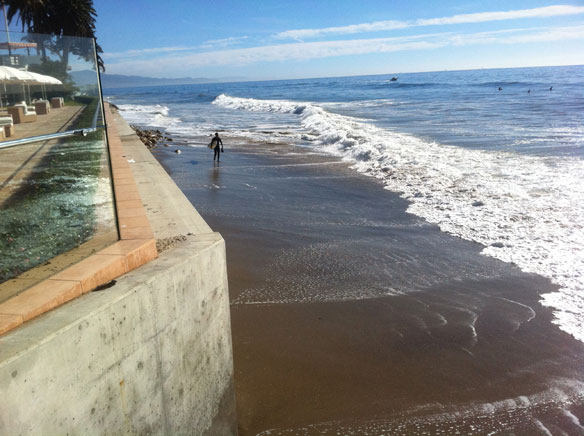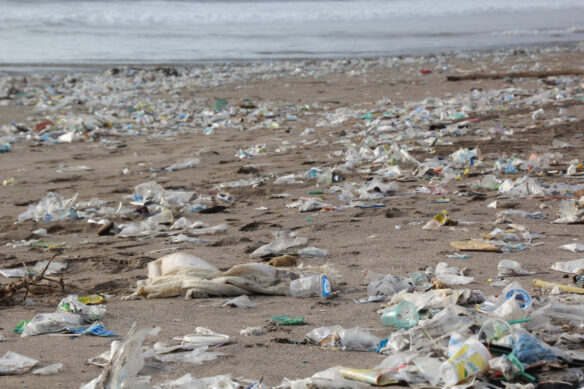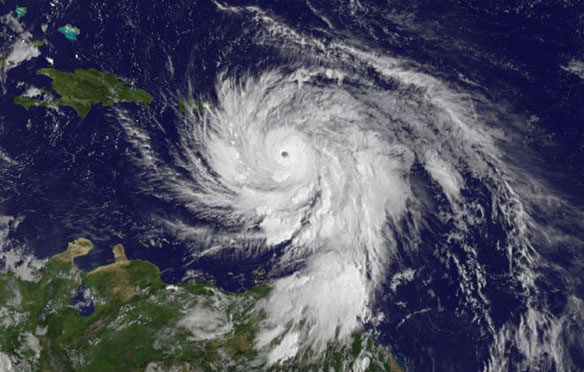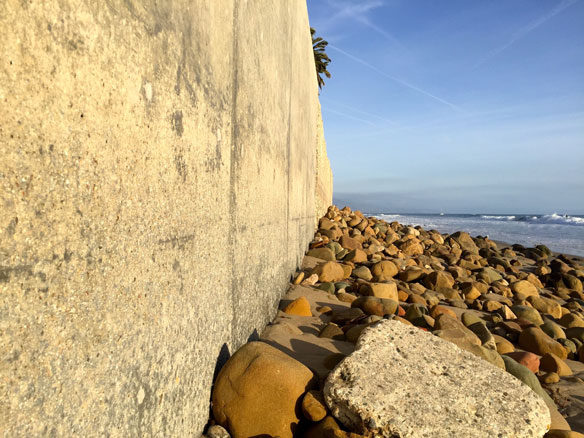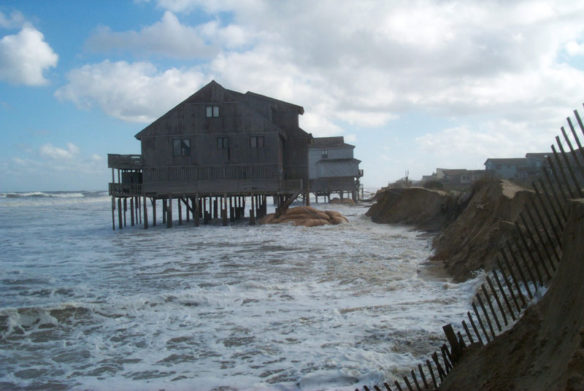Photograph: Seawall, California coast © SAF — Coastal Care
By Molly Loughney Melius, Fellow, Stanford Law School Margaret R. Caldwell, Diretor, Environment and Natural Resources Law & Policy Program, Stanford Law School*
*With contributions from:
Ralph Faust, Philip King, Robert Young, Dean Misczynski, Paul Rosenstiel, Tim Eichenberg, Megan M. Herzog, Dan R. Reineman, and Deborah Sivas
Executive Summary:
In response to erosion and storm events, Californians have built seawalls, revetments, and other “coastal armoring” structures along significant portions of California’s coast. Coastal armoring now occupies more than 110 miles, or at least 10 percent, of the overall California coastline, including 33 percent of the southern California coastline.(1) This coastal armoring has diminished California’s beaches and habitat, irreversibly altered bluffs, caused increased erosion to neighboring properties, and marred the natural beauty of the coast.
A common perception is that seawalls and revetments protect the coast. Although such armoring structures may temporarily protect property from encroachment by the sea, they accelerate erosion of existing beaches and coastal habitats in the areas where they are located, limit beach access, and impede coastal recreation. Scientific evidence shows that coastal armoring structures prevent coastal ecosystems from migrating inland and cut off sand supply by preventing natural erosion processes. Put simply, when placed on an eroding or retreating beach, armoring structures will cause that beach to narrow and eventually disappear.(2) Wave energy reflecting off of shoreline armoring structures also undercuts the beach and can hasten coastal erosion in front of the structure as well as on neighboring properties, harming those properties and stimulating yet more armoring.(3) In short, many of California’s beaches, and the amenities and ecosystems they provide, may inevitably disappear due to armoring.
This risk of beach loss is increasing. Over 80 percent of the California coastline is actively eroding.(4) The projected impacts of climate change along California’s coast – including accelerated rates of sea level rise(5) and erosion and inundation from storms that may be more frequent and powerful – will place many coastal properties and ecosystems at increased risk of damage and loss.(6) With 85 percent of Californians living or working in areas affected by sea level rise, and California’s coastal population expected to grow significantly over the coming decades, pressure to armor the coast to protect development and community infrastructure will likely intensify.(7) Unfortunately, this increased armoring will cause faster and more widespread loss of the beaches and ecosystems that make the coast so valuable to many Californians.(8) Efforts by the California Coastal Commission to mitigate coastal armoring will be reviewed by the state Supreme Court in the coming months, indicating the importance of this issue.(9)
In California, as in any jurisdiction, decisions about whether to armor a section of coastline – or to make alternative investments in coastal hazard reduction – are driven by interactions among social, economic, political, environmental, technical, and legal factors. To date, few have characterized these factors comprehensively, and in connection to one another, to better understand the big picture of how coastal armoring will impact California’s coastline. To address the interdisciplinary nature of this problem, Stanford Law School’s Environmental and Natural Resources Law & Policy Program invited a mix of legal, policy, and technical experts from California and beyond to share knowledge and suggestions regarding a range of coastal armoring issues over the course of two multi-day workshops.
We considered coastal armoring in the framework of the following goals:
• Preserving the economic, recreational and environmental value of beach and other coastal ecosystems, as well as public access to coastal resources;
• Improving regulation, mitigation, and adaptive management of armoring projects;
• Promoting the use of setbacks and other non-armoring mechanisms to avoid and mitigate long-term risks from sea level rise and related hazards;
• Promoting local land use planning in the coastal zone that makes use of a broader set of risk reduction strategies and discourages armoring;
• Promoting coastal hazard planning and mitigation approaches that incorporate sea level rise considerations and favor non-armoring solutions;
• Promoting insurance programs and regulations that do not incentivize armoring; and
• Developing and advancing financing mechanisms to support non-armoring solutions, such as nature-based coastal adaptation.
The working group’s findings address how coastal decision-makers might better analyze, prevent, and mitigate shoreline armoring impacts and eliminate institutional incentives that have led to intense coastal development and maladaptive responses to coastal changes.(10) The working group’s key findings and recommendations for improving shoreline armoring management statewide are described below.(11)
Key Findings
California’s “armored coast” is the product of many ad hoc, individual public and private sector decisions favoring protection of the built environment over preservation of at-risk public trust(12) resources such as beaches, public access and recreation, wetlands, and intertidal habitats. In spite of the documented environmental, social, and economic costs of armoring, many barriers to limiting coastal armoring remain.
1) California’s laws and policies enable imprudent coastal armoring and impede strategic decision-making that might protect coastal public trust resources. In particular:
• The California Coastal Act’s provision that allows armoring for “existing development” and the California Coastal Commission’s interpretation and application of that provision in some cases has led to increased armoring and the loss of public trust resources.(13)
• There is a conflict in the Coastal Act between the language in Section 30235, which states the Coastal Commission “shall” allow armoring to protect existing structures, and the overarching goals and objectives of Chapter 3 of the Coastal Act, which call for protection of beach access, coastal resources, and scenic views.(14)
• The Coastal Commission needs stronger enforcement authority to adequately deter and remediate unlawful armoring structures.(15)
• Many armoring structures are installed with little to no analysis of the impacts they will have on the beach, ecosystems, or neighboring properties because property owners wait to apply for permits until there is an imminent emergency, at which time armoring structures may be installed without substantive review.(16)
• The Coastal Commission has struggled to determine and assess consistent and adequate fees as mitigation for adverse effects of armoring structures and has not addressed impacts to ecosystems or ecosystem services when calculating mitigation fees.
2) Local governments lack reliable, adequate scientific and legal information to guide their decision-making with respect to coastal armoring; they also lack financial support and regulatory incentives to appropriately consider sea level rise and related coastal hazards in their infrastructure and coastal land-use planning.
3) Among private property owners and regulators alike, there is a lack of attention to nature-based and other non-armoring responses to coastal hazards and sea level rise, in part because existing disaster relief policies, insurance programs, and inadequate mitigation fees for armoring do not sufficiently require property owners to internalize the cost of development in high-risk areas.
4) Coastal armoring remains a standard response to coastal hazards for some state- owned lands and property.
Key Recommendations (17)
1) Advance stronger statewide laws, policies, and funding mechanisms that discourage armoring and encourage non-armoring responses to erosion, storm events, and sea level rise. These responses include, where feasible and appropriate, natural protective infrastructure and relocating property away from coastal hazards.
• To limit the availability of armoring, resolve conflicts in the Coastal Act between language in Section 30235 that states the Coastal Commission “shall” allow armoring to protect existing structures and the overarching goals and objectives of Chapter 3 of the Coastal Act.(18) This could be achieved with a legislative amendment to change “shall” to “may or” by adding more stringent conditions in Section 30235 that must be met in order for an armoring permit to be approved.(19)
• Clarify that the term “existing” in Section 30235 refers to structures existing when the Coastal Act was adopted.
• Amend state law to ensure that environmental impact analyses are conducted for armoring projects undertaken by Geologic Hazard Abatement Districts.
• Strengthen the Coastal Commission’s enforcement authority to address unlawful armoring structures and ensure that the Coastal Commission and the State Lands
• Commission use their existing authority and discretion to curtail armoring and its impacts.
• Limit the availability of emergency seawall permits to situations in which there is a legitimate “sudden unexpected emergency” and improve mechanisms to force removal of emergency armoring structures in the absence of longer-term authorization.(20)
• Ensure that public funding and government decision-making support sustainable climate change adaptation options and do not increase the vulnerability of infrastructure or property.
2) Ensure that local coastal planning mechanisms are used to incorporate a broader set of sustainable adaptation strategies and to discourage armoring.a.
• Ensure local governments have access to coastal adaptation planning and implementation funds.
• Require science-based planning for sea level rise and implementation of established plans in ways that protect public access and natural resources.
• Support integration of community planning (primarily under the state Government Code and the Coastal Act) and hazard prevention/mitigation planning (primarily under the federal Stafford Act).
• Support adoption of policies and ordinances that require the consideration of sea level rise in erosion rate calculations and setback determinations. Develop standard, transferable methodologies for factoring sea level rise into hazard analyses.
3) Support development and implementation of measures, including insurance programs and regulations, that require and/or incentivize private property owners to assume the risks of developing in high-hazard areas and that facilitate relocation away from hazardous areas.
4) Where possible, pursue non-armoring responses to sea level rise and related coastal hazards for state-owned and private lands, such as relocating development (e.g., buildings, parking areas, roadways, utilities) and using other managed retreat strategies.
5) Improve the availability of relevant data, guidance, and technical resources.(21)a.
• Support consistent statewide monitoring of armoring impacts and compile comprehensive statewide data regarding the use, locations, and consequences of armoring.
• Support development of legal guidance that helps state and local entities conform with constitutional limitations(22) when they promote non- armoring responses to sea level rise and related coastal hazards.
• Support development of standard methodologies for calculating impacts and identifying mitigation measures that account for the full value of impacts caused by armoring, including impacts to neighboring properties and public trust resources.
• Support pilot projects that demonstrate the feasibility and value of non- armoring solutions at the community scale.
Through these recommendations and this white paper, we hope to help California avoid and reduce maladaptive armoring responses to sea level rise and related coastal hazards, and instead to encourage more sustainable adaptation strategies for public and private structures and resources alike. California’s coastal managers must consider whether private property owners should be allowed to potentially sacrifice the public trust, public access to the beach, and the economic value of beaches in order to protect their own property. Similarly, in the case of government-funded projects, coastal managers should carefully consider how much taxpayer money should go toward temporarily stabilizing an otherwise eroding shoreline.
A more economically and ecologically sustainable approach to addressing sea level rise and related coastal hazards is critical to California’s ability to protect public access, public and private property, and coastal ecosystems now and in the future.
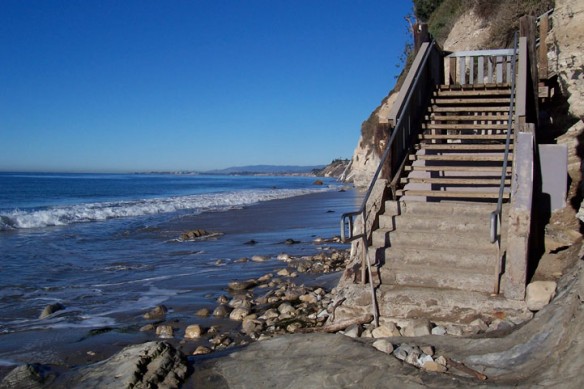
Photograph: California coast © SAF — Coastal Care

